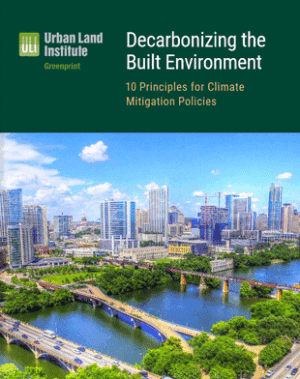City policy leaders and the real estate industry must work together when creating climate mitigation policies to maximize their effectiveness, according to Decarbonizing the Built Environment: 10 Principles for Climate Mitigation Policies, a new report released by ULI.
By the end of 2019, 31 U.S. cities set energy benchmarking policies, with 15 requiring that structures meet performance targets or undertake additional actions like energy audits, and over 70 cities have pledged to be carbon neutral by 2050.
The 10 Principles report, a collaboration between ULI’s Greenprint Center for Building Performance and the Urban Sustainability Directors Network (USDN), is intended to serve as a starting point for cities interested in engaging local real estate leaders during the shaping of climate mitigation policies, and for real estate organizations to increase their understanding of the potential impact of these policies and ways of engaging on them.
Each principle in the report is based on recommendations identified during a series of ULI City and Real Estate Sustainability Workshops that engaged more than 60 public and private leaders.
“Climate change is one of the defining issues of our time, and real estate is at the forefront of addressing this global issue,” says ULI chief executive officer W. Edward Walter. “Recognizing the monumental task at hand, ULI, in partnership with our friends at the Urban Sustainability Directors Network, sought to increase the dialogue and engagement between sustainability leaders at major real estate firms and city officials developing built-environment climate policies and programs. Together, we were able to learn from recent efforts and identify a set of principles that can serve as a foundation for more effective city/private sector partnership in developing, establishing, and implementing policies to drive building-sector decarbonization over the next 30 years. I’m proud that ULI has been at the forefront of leading this charge for our industry.”
The 10 principles outlined in the report are as follows:
- Calculate a baseline, then set interim and aspirational goals;
- Involve stakeholders early and continuously;
- Understand the business of real estate;
- Align the city’s climate goals with the larger policy ecosystem to ensure consistency;
- Connect the climate action plan to the city’s other social and economic goals;
- Be comprehensive in subjecting all buildings to the new plan;
- Prioritize existing buildings;
- Be flexible in achieving goals;
- Foster a marketplace of support; and
- Ensure compliance, reward success, and accelerate transformation.
The report encourages the real estate community to engage with local policymakers to help shape achievable climate action plans and regulations by outlining a role for real estate in each principle. Because the real estate sector currently contributes nearly 40 percent of carbon emissions globally and nearly 70 percent of emissions in urban areas, cities are beginning to pass climate legislation and initiatives that address current and new buildings. However, the real estate industry has been slow to adapt, leading to a disconnect between the two entities.
The 10 Principles report seeks to bridge the gap between the real estate and public policy sector and create meaningful engagement that will both reduce carbon emissions and work for the industry. Each principle has a designated role for real estate, providing valuable guidance on how the industry can advise the public policy sector on climate-related issues.
“We hope this report is a valuable resource that motivates and enables real estate and city leaders alike to decarbonize the built environment in a collaborative and value-generating manner,” says Brian Swett, Boston office leader, Arup, and board member of ULI’s Center for Sustainability and Economic Performance. “The scale of this climate challenge is immense, but by working together, the public and private sectors can create the right policy and economic structures to achieve building sector net carbon neutrality by midcentury while simultaneously enhancing the resilience and social equity of cities around the world.”
The report cites a number of cities that have engaged with their local real estate communities to practice these principles, including the following:
- Boston, Massachusetts: Funded by a coalition of 10 local foundations, the Boston Green Ribbon Commission (GRC) was founded in 2010 to support and drive climate action in the city. Chaired by the mayor of Boston and the cofounder of the Barr Foundation, this real estate executive group meets twice a year to discuss the bigger picture with technical working groups meeting regularly throughout the year to discuss policy details and best practices on topics such as health care and commercial real estate.
- Seattle, Washington: The Seattle Building Tune-Ups Ordinance was adopted in 2016 and requires commercial buildings over 50,000 square feet (4,600 sq m) to undergo a tune-up process to assess their operational and maintenance problems and make required corrections. The city also provides alternative pathways for buildings to comply.
- Berkeley, California: In July 2019, the city of Berkeley passed the first ordinance requiring new buildings to be all-electric. A key item to consider was the California state energy code, which functions on a triannual cycle, with the next version of code going into effect in 2020. The next version of code provides a baseline for all-electric buildings and an easy path for all-electric low-rises but does not allow for central heat pump water heaters. If Berkeley required all-electric buildings before 2020, the buildings would not meet code. In addition, if a building cannot achieve all-electric status without meeting code, it is exempt from the ordinance.
“Public- and private-sector collaboration will be crucial to advancing greenhouse gas emissions reductions in the built environment,” says Garrett Fitzgerald, strategic collaboration director, Urban Sustainability Directors Network. “We are excited for communities to begin applying these critical principles as they begin to navigate affordability, sustainability, and resilience priorities for the ongoing pandemic and future economic recovery.”





